-
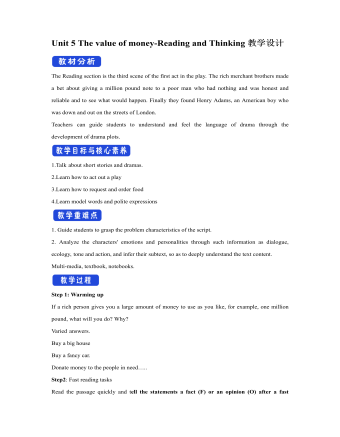
新人教版高中英语必修3Unit 5 The value of money-Reading and Thinking教学设计二
? Could you offer me some kind of work here?? I don’t want your charity, I just want an honest job.? Careless: I landed in Britain by accident.Step 7:Consolidation.? Find Henry? Roderick and Oliver were I .making a bet when they saw Henry, a poor young man. ? Know Henry? About a month ago, Henry was sailing and later he found himself carried out to sea by a strong wind. Fortunately, he 2.was spotted by a ship. And it was the ship that brought him to 3.England? Offer money to Henry ? Oliver and Roderick gave Henry a letter and told him that there was money in it. They 4.persuaded him to accept it, and made him 5.promise that it wouldn't be opened until 2 o'clock.Step 8:Language pointsa large amount of: a large quantity of; a great deal ofe.g. They bought a large amount of furniture before they moved their new house.make a bet: make an arrangement to risk money, etc. on an event of which the result is doubtful.e.g. We made a bet on the result of the match.permit sb to do something: allow somebody to do somethinge.g. My mother doesn’t permit me to ride in the street after it rained.by accident: as a result of chancee.g. I only found it by accident.stare at: look at somebody or something with the eyes wide open in a fixed gaze( in astonishment, wonder, fear, etc)to be honest: to tell you the truth; to be franke.g. To be honest, I don’t think we have a chance of winning.Step7 Homework:What do you think will happen to Henry? Will the bank-note help him or get him into trouble?
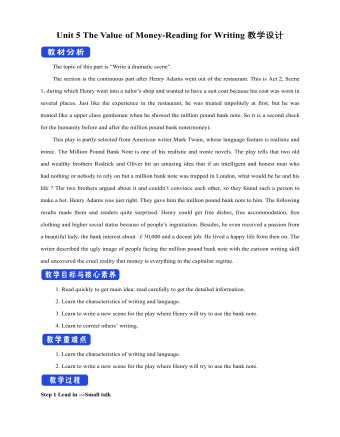
新人教版高中英语必修3Unit 5 The Value of Money-Reading for Writing教学设计二
2. 您能看到, 我头发太长了。You can see that my hair is much too long.3. 无论什么时候, 只要您想回来就回来。Please come back whenever you want.4. 您仅有很少的头发要理! You only have too little hair to cut !5. 为您服务是我的荣幸!It is my honour to serve you!Step 9 Writing(Henry is walking down the street when he sees a sign for a place that cuts hair. He decides to have it cut. )H=Henry B=BarberH: Good afternoon, I’d like to have my hair cut, if I may. (The barber looks at Henry’s hair and continues cutting another man’s hair. ) Er, I’d really like a haircut. As you can see it’s much too long. B: (in a rude manner) Yes, I can see that. Indeed, I can. H: Fine, well, I’ll have a seat then. (He sits in one of the barber’s chairs. The barber turns to look at Henry. )B: It’s quite expensive here, you know! Are you sure you can afford it?H: Yes. I think so. (After his hair is cut, the barber tells Henry how much he must pay. Henry shows the barber the bank note. )B: Why Mr. . . (looks shocked)H: Adams. Henry Adams. I’m sorry. I don’t have any change. B: Please don’t worry! (wearing a big smile) Nothing to worry about! Nothing at all! Please come back whenever you want, even if you only have too little hair to cut! It will be my honour to serve you!Step 10 Pair workExchange drafts with a partner. Use this checklist to help your partner revise his/her draft.1. Are all the elements of a play included and in good order ?2. Do the character use suitable language ?3. Are the stage directions clear and useful ?4. Is the plot clear and exciting enough ?
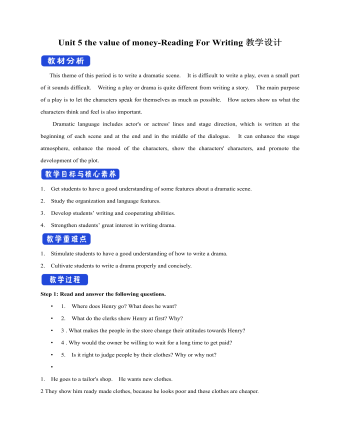
新人教版高中英语必修3Unit 5 the value of money-Reading For Writing教学设计一
【参考范文】Narrator:(Henry is smiling as he leaves the restaurant. As he is walking down the street, he sees a sign for a place that cuts hair. He decides to get it cut. )H=Henry;B=Barber;R=rude manH:Good afternoon, I'd like to get a cut, if I may. (The barber looks at Henry's hair and continues cutting another man's hair. )Er, I'd really like a haircut. As you can see it's much too long. B:(in a rude manner) Yes, I can see that. Indeed, I can. H:Fine, well I'll have a seat then. (He sits in one of the barber's chairs. The barber turns to look at Henry. )B:It's quite expensive here, you know!Are you sure you can afford it?H:Yes. I think so. (In comes the rude man. )R:Hey you there. I need a haircut quickly. Can you do me straightaway?B:All right, then, get in the chair and I'll see what I can do. R:Thank you. (sits down in one of the barber's chairs)H:Excuse me, but I was here first. Aren't you going to do my hair first?B:This man's in a hurry. H:Well so am I!I insist that you cut my hair first. B:OK, but I'll have to be quick. This gentleman is waiting. H:Thank you. (They both become quiet. After his hair is cut, the barber tells Henry how much he must pay. Henry shows the barber the bank note. )B:Why, Mr . . . (looks shocked)H:Adams. Henry Adams. I'm sorry, I don't have any change. R:You're that Mr Adams! Well,I'm glad I waited or I might never have known it was you. B:Why, Mr Adams, please don't worry!(wearing a big smile) Nothing to worry about!Nothing at all!Please come back any time, even if you only need too little hairs cut!It will be my honour to serve you!
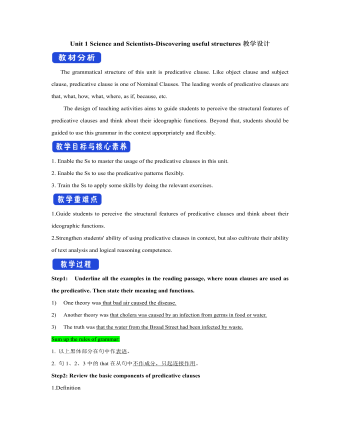
新人教版高中英语选修2Unit 1 Science and Scientists-Discovering useful structures教学设计
The grammatical structure of this unit is predicative clause. Like object clause and subject clause, predicative clause is one of Nominal Clauses. The leading words of predicative clauses are that, what, how, what, where, as if, because, etc.The design of teaching activities aims to guide students to perceive the structural features of predicative clauses and think about their ideographic functions. Beyond that, students should be guided to use this grammar in the context apporpriately and flexibly.1. Enable the Ss to master the usage of the predicative clauses in this unit.2. Enable the Ss to use the predicative patterns flexibly.3. Train the Ss to apply some skills by doing the relevant exercises.1.Guide students to perceive the structural features of predicative clauses and think about their ideographic functions.2.Strengthen students' ability of using predicative clauses in context, but also cultivate their ability of text analysis and logical reasoning competence.Step1: Underline all the examples in the reading passage, where noun clauses are used as the predicative. Then state their meaning and functions.1) One theory was that bad air caused the disease.2) Another theory was that cholera was caused by an infection from germs in food or water.3) The truth was that the water from the Broad Street had been infected by waste.Sum up the rules of grammar:1. 以上黑体部分在句中作表语。2. 句1、2、3中的that在从句中不作成分,只起连接作用。 Step2: Review the basic components of predicative clauses1.Definition
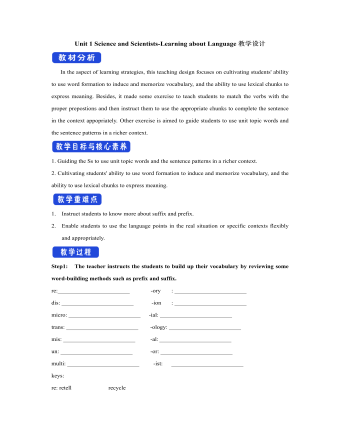
新人教版高中英语选修2Unit 1 Science and Scientists-Learning about Language教学设计
Step 7: complete the discourse according to the grammar rules.Cholera used to be one of the most 1.__________ (fear) diseases in the world. In the early 19th century, _2_________ an outbreak of cholera hit Europe, millions of people died. But neither its cause, 3__________ its cure was understood. A British doctor, John Snow, wanted to solve the problem and he knew that cholera would not be controlled _4_________ its cause was found. In general, there were two contradictory theories 5 __________ explained how cholera spread. The first suggested that bad air caused the disease. The second was that cholera was caused by an _6_________(infect) from germs in food or water. John Snow thought that the second theory was correct but he needed proof. So when another outbreak of cholera hit London in 1854, he began to investigate. Later, with all the evidence he _7_________ (gather), John Snow was able to announce that the pump water carried cholera germs. Therefore, he had the handle of the pump _8_________ (remove) so that it couldn't be used. Through his intervention,the disease was stopped in its tracks. What is more, John Snow found that some companies sold water from the River Thames that __9__________________ (pollute) by raw waste. The people who drank this water were much more likely _10_________ (get) cholera than those who drank pure or boiled water. Through John Snow's efforts, the _11_________ (threaten) of cholera around the world saw a substantial increase. Keys: 1.feared 2.when 3. nor 4.unless 5.that/which 6.infection 7.had gathered 8.removed 9.was polluted 10.to get 11. threat
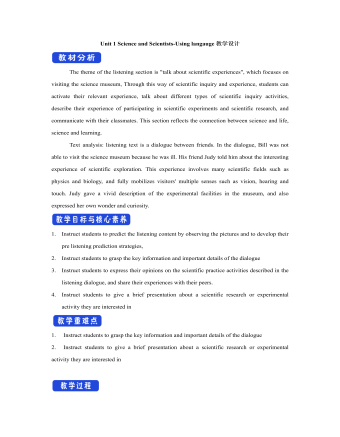
新人教版高中英语选修2Unit 1 Science and Scientists-Using langauge教学设计
This happens because the dish soap molecules have a strong negative charge, and the milk molecules have a strong positive charge. Like magnets, these molecules are attracted to each other, and so they appear to move around on the plate, taking the food coloring with them, making it look like the colors are quickly moving to escape from the soap.Listening text:? Judy: Oh, I'm so sorry that you were ill and couldn't come with us on our field trip. How are you feeling now? Better?? Bill: Much better, thanks. But how was it?? Judy: Wonderful! I especially liked an area of the museum called Light Games.it was really cool. They had a hall of mirrors where I could see myself reflected thousands of times!? Bill: A hall of mirrors can be a lot of fun. What else did they have?? Judy: Well, they had an experiment where we looked at a blue screen for a while, and then suddenly we could see tiny bright lights moving around on it. You'll never guess what those bright lights were!? Bill: Come on, tell me!? Judy: They were our own blood cells. For some reason, our eyes play tricks on us when we look at a blue screen, and we can see our own blood cells moving around like little lights! But there was another thing I liked better. I stood in front of a white light, and it cast different shadows of me in every color of the rainbow!? Bill: Oh, I wish I had been there. Tell me more!? Judy: Well, they had another area for sound. They had a giant piano keyboard that you could use your feet to play. But then, instead of playing the sounds of a piano, it played the voices of classical singers! Then they had a giant dish, and when you spoke into it, it reflected the sound back and made it louder. You could use it to speak in a whisper to someone 17 meters away.? Bill: It all sounds so cool. I wish I could have gone with you? Judy: I know, but we can go together this weekend. I'd love to go there again!? Bill: That sounds like a great idea!
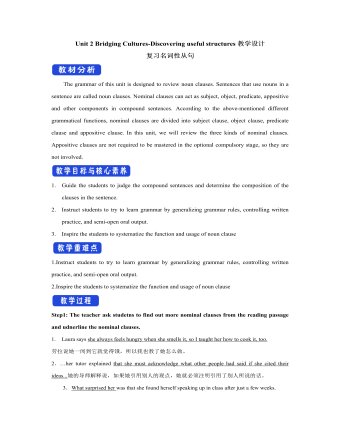
新人教版高中英语选修2Unit 2 Bridging Cultures-Discovering useful structures教学设计
The grammar of this unit is designed to review noun clauses. Sentences that use nouns in a sentence are called noun clauses. Nominal clauses can act as subject, object, predicate, appositive and other components in compound sentences. According to the above-mentioned different grammatical functions, nominal clauses are divided into subject clause, object clause, predicate clause and appositive clause. In this unit, we will review the three kinds of nominal clauses. Appositive clauses are not required to be mastered in the optional compulsory stage, so they are not involved.1. Guide the students to judge the compound sentences and determine the composition of the clauses in the sentence.2. Instruct students to try to learn grammar by generalizing grammar rules, controlling written practice, and semi-open oral output.3. Inspire the students to systematize the function and usage of noun clause1.Instruct students to try to learn grammar by generalizing grammar rules, controlling written practice, and semi-open oral output.2.Inspire the students to systematize the function and usage of noun clauseStep1: The teacher ask studetns to find out more nominal clauses from the reading passage and udnerline the nominal clauses.
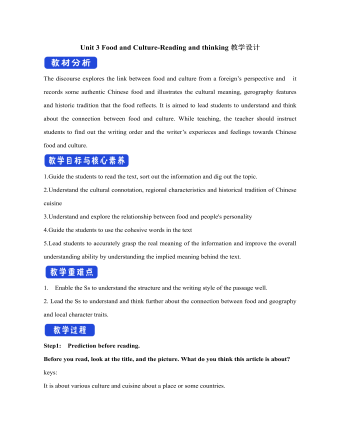
新人教版高中英语选修2Unit 3 Food and Culture-Reading and thinking教学设计
The discourse explores the link between food and culture from a foreign’s perspective and it records some authentic Chinese food and illustrates the cultural meaning, gerography features and historic tradition that the food reflects. It is aimed to lead students to understand and think about the connection between food and culture. While teaching, the teacher should instruct students to find out the writing order and the writer’s experieces and feelings towards Chinese food and culture.1.Guide the students to read the text, sort out the information and dig out the topic.2.Understand the cultural connotation, regional characteristics and historical tradition of Chinese cuisine3.Understand and explore the relationship between food and people's personality4.Guide the students to use the cohesive words in the text5.Lead students to accurately grasp the real meaning of the information and improve the overall understanding ability by understanding the implied meaning behind the text.1. Enable the Ss to understand the structure and the writing style of the passage well.2. Lead the Ss to understand and think further about the connection between food and geography and local character traits.Step1: Prediction before reading. Before you read, look at the title, and the picture. What do you think this article is about?keys:It is about various culture and cuisine about a place or some countries.
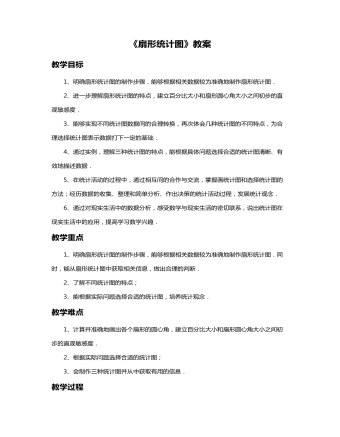
扇形统计图教案教学设计
教学目标1、明确扇形统计图的制作步骤,能够根据相关数据较为准确地制作扇形统计图.2、进一步理解扇形统计图的特点,建立百分比大小和扇形圆心角大小之间初步的直观敏感度.3、能够实现不同统计图数据间的合理转换,再次体会几种统计图的不同特点,为合理选择统计图表示数据打下一定的基础.4、通过实例,理解三种统计图的特点,能根据具体问题选择合适的统计图清晰、有效地描述数据.5、在统计活动的过程中,通过相互间的合作与交流,掌握画统计图和选择统计图的方法;经历数据的收集、整理和简单分析、作出决策的统计活动过程,发展统计观念.6、通过对现实生活中的数据分析,感受数学与现实生活的密切联系,说出统计图在现实生活中的应用,提高学习数学兴趣.
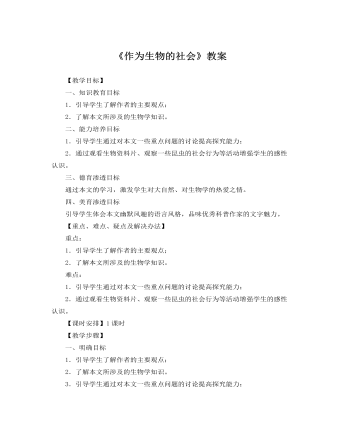
人教版高中语文必修5《作为生物的社会》教案
二、整体感知1.导入新课同学们《细胞生命的礼赞》是一个医学家、生物学家关于生命、人生、社会乃至宇宙的思考。思想博大而深邃,信息庞杂而新奇,批评文明,嘲弄愚见,开阔眼界、激发思索。而其文笔又少见的优美、清新、幽默、含蓄,无愧当今科学散文中的大家手笔。无怪乎自1974年出版后,立即引起美国读书界和评论界的巨大反响和热烈欢呼,获得当年美国国家图书奖,此后18年来由好几家出版社印了二十多版,至今畅行不衰!年过花甲的刘易斯·托马斯的名字因这一本小书而家喻户晓,有口皆碑,以至于在他接连抛出后两本书时,书商都不用再作广告,只喊声"《细胞生命的礼赞》一书作者刘易斯·托马斯的新著"就够了。今天我们就来学习选自这部书的精彩章节《作为生物的社会》(板书课题)。
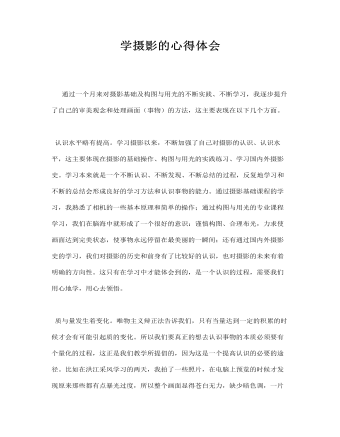
学摄影的心得体会
质与量发生着变化。唯物主义辩正法告诉我们,只有当量达到一定的积累的时候才会有可能引起质的变化。所以我们要真正的想去认识事物的本质必须要有个量化的过程,这正是我们教学所提倡的,因为这是一个提高认识的必要的途径。比如在洪江采风学习的两天,我拍了一些照片,在电脑上预览的时候才发现原来那些都有点暴光过度,所以整个画面显得苍白无力,缺少暗色调,一片迷茫的感觉。虽然我当时是采用的准确的暴光,但对这相机来说还是暴光偏高,这是我没有对本相机的一些性能有个全面的了解
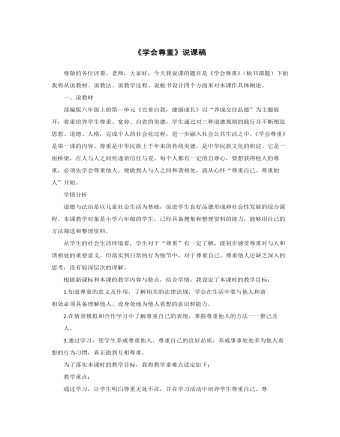
学会尊重 说课稿
尊敬的各位评委、老师,大家好,今天我说课的题目是《学会尊重》(板书课题)下面我将从说教材、说教法、说教学过程、说板书设计四个方面来对本课作具体阐述。一、说教材部编版六年级上册第一单元《完善自我,健康成长》以“养成交往品德”为主题展开,着重培养学生尊重、宽容、自省的美德,学生通过对三种道德规则的践行并不断塑造思想、道德、人格,完成个人的社会化过程,进一步融入社会公共生活之中。《学会尊重》是第一课的内容。尊重是中华民族上千年来的传统美德,是中华民族文化的积淀。它是一座桥梁,在人与人之间传递着信任与爱。每个人都有一定的自尊心,要想获得他人的尊重,必须先学会尊重他人。要做到人与人之间和谐相处,就从心怀“尊重自己、尊重他人”开始。学情分析道德与法治是以儿童社会生活为基础,促进学生良好品德形成和社会性发展的综合课程。本课教学对象是小学六年级的学生,已经具备搜集和整理资料的能力,能够用自己的方法筛选和整理资料。从学生的社会生活环境看,学生对于“尊重”有一定了解,能初步感受尊重对与人和谐相处的重要意义。但落实到日常的行为细节中,对于尊重自己、尊重他人还缺乏深入的思考,没有较深层次的理解。
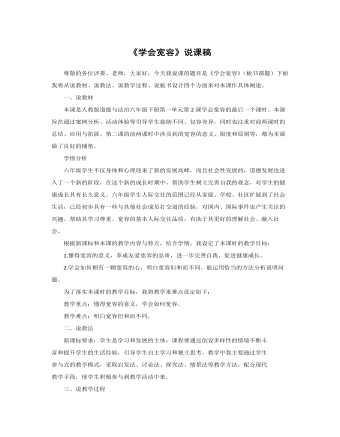
学会宽容 说课稿
说教材本课是人教版道德与法治六年级下册第一单元第2课学会宽容的最后一个课时。本课旨在通过案例分析、活动体验等引导学生接纳不同、包容差异,同时也注重对前两课时的总结、应用与拓展。第二课的前两课时中涉及到的宽容的意义、限度和原则等,都为本课做了良好的铺垫。学情分析六年级学生不仅身体和心理迎来了新的发展高峰,而且社会性发展的,道德发展也进入了一个新的阶段,在这个新的成长时期中,帮助学生树立完善自我的观念,对学生的健康成长具有长久意义。六年级学生人际交往的范围已经从家庭、学校、社区扩展到了社会生活,已经初步具有一些与其他社会成员打交道的经验,对国内、国际事件也产生关注的兴趣。帮助其学习尊重、宽容的基本人际交往品质,有助于其更好的理解社会、融入社会。根据新课标和本课的教学内容与特点,结合学情,我设定了本课时的教学目标:1.懂得宽容的意义,养成友爱宽容的品质,进一步完善自我,促进健康成长。2.学会如何拥有一颗宽容的心,明白宽容但和而不同。能运用恰当的方法分析说明问题。为了落实本课时的教学目标,我将教学重难点设定如下:教学重点:懂得宽容的意义,学会如何宽容。教学难点:明白宽容但和而不同。
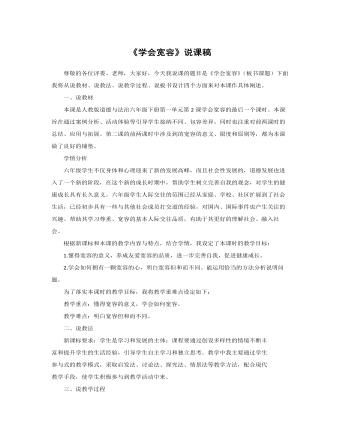
学会反思 说课稿
尊敬的各位评委、老师,大家好,今天我说课的题目是《学会反思》(板书课题 )下面我将从说教材、说教法、说教学过程、说板书设计四个方面来对本课作具体阐述。1、说教材本课是第一单元“完善自我 健康成长"的第3课,本课是在前 五年我的健康成长主题学习的基础上,聚焦反思。本课包括“生活离 不开反思"和“养成反思好习惯"两部分内容。教学时应从学生己有 知识经验出发,运用生动活泼例子、故事,让学生参加活动,在实践 中明白反思的重要性,从而学会反思的方法。学情分析本班多数学生养成良好的学习和生活习惯,对道德与法治这一学科很感兴趣。由于本班留守儿童较多,缺乏家庭教育,导致了少部分的学困生,这就要求教师加强对学困生的教育和引导,让他们尽快养成良好的学习习惯。根据新课标和本课的教学内容与特点,结合学情,我设定了本课时的教学目标:1.懂得反思的意义,养成反思的行为习惯,进一步完善自我,促进健康成长。2.学习从不同的角度反思自己。3.初步掌握收集、整理和运用信息的能力。为了落实本课时的教学目标,我将教学重难点设定如下:教学重点:懂得反思的意义,养成反思的行为习惯。教学难点:学习从不同的角度反思自己。
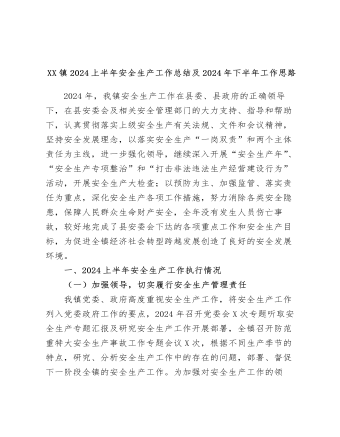
XX镇2024上半年安全生产工作总结及2024年下半年工作思路
(一)完善安全生产体制建设,提高群众安全意识根据我镇实际,逐步完善我镇安全生产有关制度建设,积极探索安全生产行政执法绩效评估和奖惩办法,重点抓好《安全生产法》、《省安全生产条例》等安全生产法律法规的贯彻落实,通过多渠道的宣传方式和群众喜闻乐见的活动,努力提高全民安全生产意识。(二)强化安全生产责任落实,提高企业安全素质通过规范化我镇3家规模企业安全生产,以点带面,实现全镇企业的安全生产规范化。我镇将结合实际制定规范化考评细则,帮助企业建立健全安全生产规章制度,落实安全生产责任制,开展安全教育培训,完善安全工作台帐、建立和完善应急预案等。采用安全性能可靠的新技术、新工艺、新设备和新材料,不断改善安全生产条件;重视、尊重和保障职工群众在安全生产方面的合法权益,充分调动职工群众参与、监督安全生产的积极性。对全镇企业进行差异化评定,对安全工作不重视的、不落实的,评分低的,重点监管,对安全工作重视的,落实的,进行常规化监管。
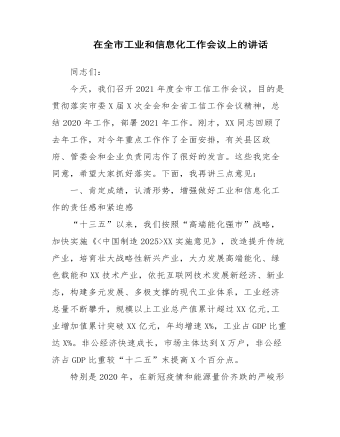
在全市工业和信息化工作会议上的讲话
“十三五”以来,我们按照“高端能化强市”战略,加快实施《<中国制造2025>XX实施意见》,改造提升传统产业,培育壮大战略性新兴产业,大力发展高端能化、绿色载能和XX技术产业,依托互联网技术发展新经济、新业态,构建多元发展、多极支撑的现代工业体系,工业经济总量不断攀升,规模以上工业总产值累计超过XX亿元,工业增加值累计突破XX亿元,年均增速X%,工业占GDP比重达X%。非公经济快速成长,市场主体达到X万户,非公经济占GDP比重较“十二五”末提高X个百分点。
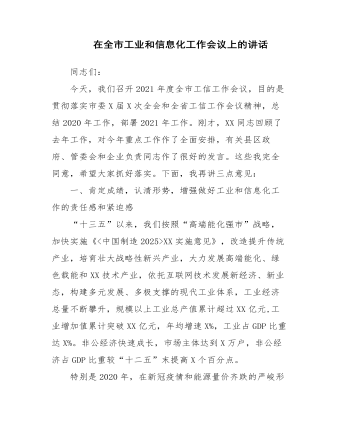
在全市工业和信息化工作会议上的讲话发言
“十三五”以来,我们按照“高端能化强市”战略,加快实施《<中国制造2025>XX实施意见》,改造提升传统产业,培育壮大战略性新兴产业,大力发展高端能化、绿色载能和XX技术产业,依托互联网技术发展新经济、新业态,构建多元发展、多极支撑的现代工业体系,工业经济总量不断攀升,规模以上工业总产值累计超过XX亿元,工业增加值累计突破XX亿元,年均增速X%,工业占GDP比重达X%。非公经济快速成长,市场主体达到X万户,非公经济占GDP比重较“十二五”末提高X个百分点。
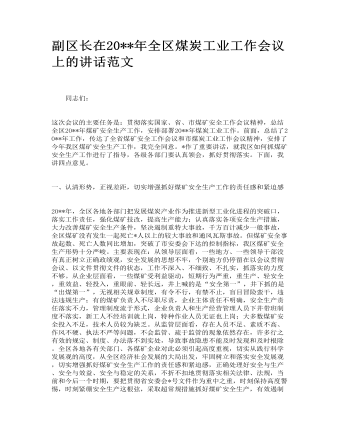
副区长在全区煤炭工业工作会议上的讲话范文
一、认清形势,正视差距,切实增强抓好煤矿安全生产工作的责任感和紧迫感 20**年,全区各地各部门把发展煤炭产业作为推进新型工业化进程的突破口,落实工作责任,强化煤矿技改,提高生产能力;认真落实各项安全生产措施,大力改善煤矿安全生产条件,坚决遏制重特大事故,千方百计减少一般事故,全区煤矿没有发生一起死亡*人以上的较大事故和通风瓦斯事故。但煤矿安全事故起数、死亡人数同比增加,突破了市安委会下达的控制指标,我区煤矿安全生产形势十分严峻。主要表现在:从领导层面看,一些地方、一些领导干部没有真正树立正确政绩观,安全发展的思想不牢,个别地方仍停留在以会议贯彻会议、以文件贯彻文件的状态,工作不深入、不细致、不扎实,抓落实的力度不够。从企业层面看,一些煤矿受利益驱动,短期行为严重,重生产、轻安全,重效益、轻投入,重眼前、轻长远,井上喊的是“安全第一”,井下抓的是“出煤第一”,无视相关规章制度,有令不行,有禁不止,盲目冒险蛮干,违法违规生产;有的煤矿负责人不尽职尽责,企业主体责任不明确,安全生产责任落实不力,管理制度流于形式,企业负责人和生产经营管理人员下井带班制度不落实,新工人不经培训就上岗,特种作业人员无证也上岗;大多数煤矿安全投入不足,技术人员较为缺乏。从监管层面看,存在人员不足、素质不高、作风不硬、执法不严等问题,不会监管、疏于监管的现象依然存在,许多行之有效的规定、制度、办法落不到实处,导致事故隐患不能及时发现和及时根除。全区各地各有关部门、各煤矿企业对此必须引起高度重视,切实从践行科学发展观的高度,从全区经济社会发展的大局出发,牢固树立和落实安全发展观,切实增强抓好煤矿安全生产工作的责任感和紧迫感,正确处理好安全与生产、安全与效益、安全与稳定的关系,不折不扣地贯彻落实相关法律、法规,当前和今后一个时期,要把贯彻省安委会*号文件作为重中之重,时刻保持高度警惕,时刻紧绷安全生产这根弦,采取超常规措施抓好煤矿安全生产,有效遏制煤矿事故发生,坚决杜绝较大以上事故发生,促进我区煤炭工业安全发展、健康发展、可持续发展。
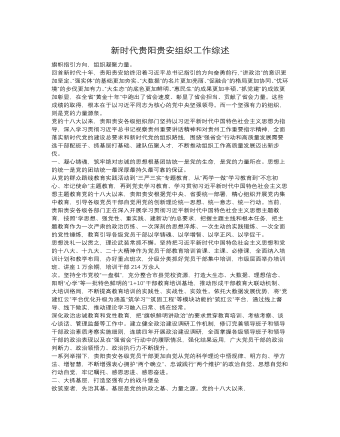
新时代贵阳贵安组织工作综述
全方位培养支持人才,积极推动政企互动、政校互动、政社互动、校企互动,充分发挥全省高校、科研机构、高层次人才集聚地优势,培育实用型、技能型人才,建立覆盖全面、资源共享、衔接有序、梯次递进的人才培养体系。打造数博会、大数据科创城、国家大数据(贵州)综合试验区展示中心“一会一城一中心”,组建中科院软件所贵阳分部、贵阳高校科研院所科技创新联盟,建成院士工作站3个,博士后工作站9个,各类国家级平台70个、省级平台365个,不断深化人才链、产业链、创新链、资金链“四链融合”,持续推动以才兴业、以业育才、产才共融,人才潜能得到充分挖掘和开发,人才质量不断提升。15人入选国家级人才计划,18人入选国务院特殊津贴专家,10人入选全国技术能手,获评重点联系省管专家3人、省管专家31人,培养选拔市管专家227人。人才平台,就是事业舞台。贵阳贵安围绕“1+7+1”重点产业,充分发挥全省高校、科研机构、高层次人才集聚地优势,培育国家专精特新“小巨人”企业68家、省级科技型企业3353家、高新技术企业1337家,大数据企业突破5000家在贵阳贵安大地上创新创造其时已至、其势已成、其风正盛。广大人才不断在贵阳贵安实现筑梦、追梦、圆梦。
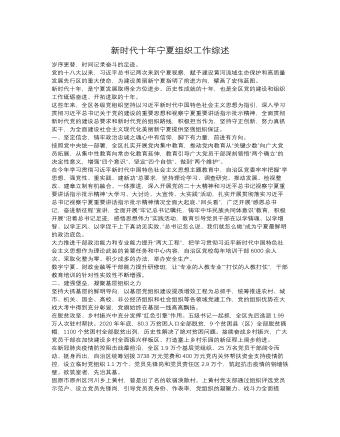
新时代十年宁夏组织工作综述
(上海)科创中心(人才大厦),全区博士总量突破2000人,人才集聚效应持续显现。坚持载体孵育人才、成就人才,围绕重点产业和重点领域发展需求,建设重点实验室、工程技术研究中心等各类科技创新平台1321个,先后在煤制油、铸造3D打印、奶牛选育等领域攻克了一批技术瓶颈,宁夏迈入国家二类创新地区,马玉山当选中国工程院院士,姚敏领衔团队获国家科技进步奖一等奖。2022年7月,宁夏围绕农业重点产业重大技术需求,发布了第一批“揭榜挂帅”项目榜单,很快,枸杞、葡萄酒、奶产业等4个农业科技项目的“帅位”各有归属,在“赛马”和定向委托等制度推动下,全区人才链与产业链进一步融合。积极构建包括领军人才、青年拔尖人才、青年托举人才等重大人才培养工程在内的梯次培养计划,坚持“走出去”与“请进来”相结合,不断开辟人才交流深造渠道。深化人才发展体制机制改革,最大限度向用人主体授权、为人才松绑,职称评审、岗位评聘、绩效工资管理、科研项目管理赋权改革试点取得积极成效,人才创新创造活力持续释放。





















